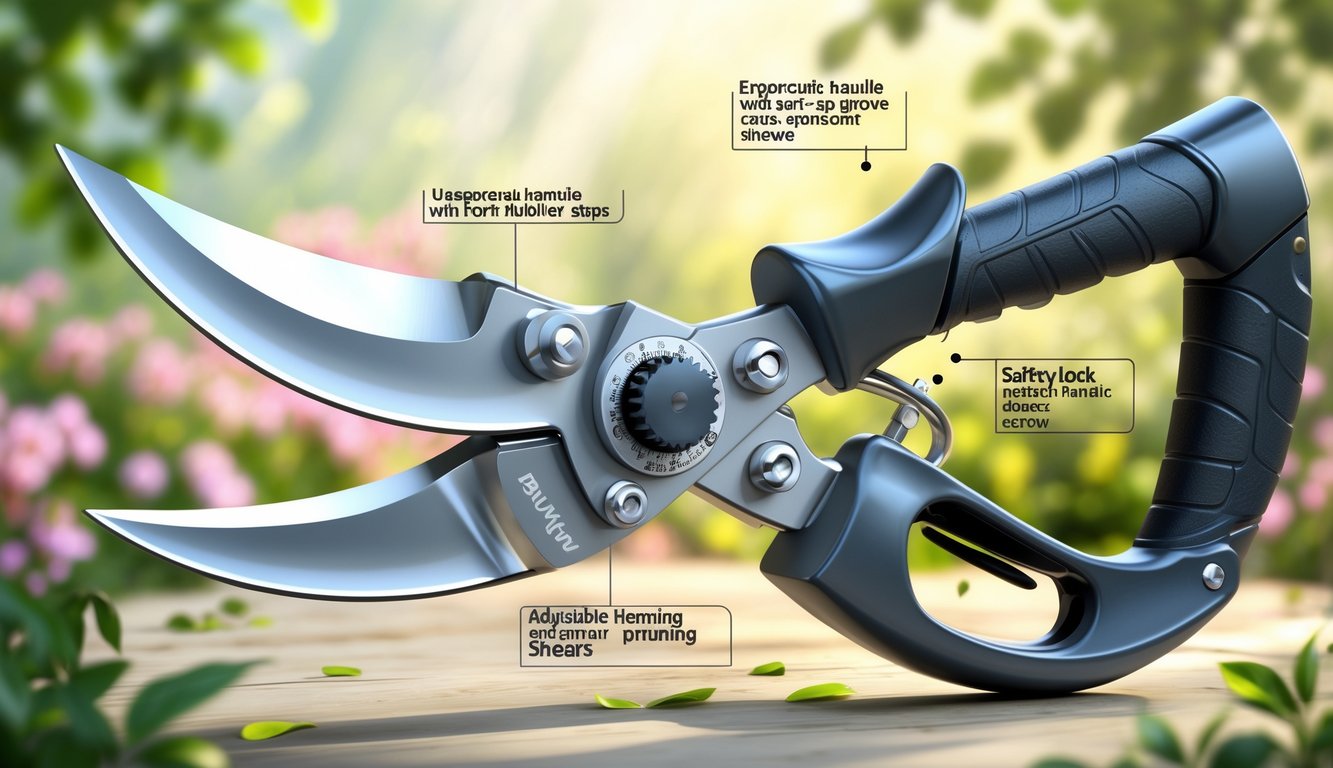
Types of Pruning Shears With Hidden Benefits
Supposedly, picking pruning shears is easy. Meanwhile, I’m still picking thorns out of my sleeve from last year’s “universal” disaster. Not all pruners are made equal, and if you miss one sneaky feature, you’ll be muttering at stubborn stems or complaining about sore hands while freezing rain drips off your hood.
Bypass Pruners for Cleaner Cuts
Alright, let’s talk bypass pruners. I mean, why do I even bother with anything else when I want a cut that doesn’t look like a squirrel gnawed it? Blunt tools just tick me off and, honestly, plants don’t exactly bounce back from those shredded branch ends. The scissor action on bypass pruners? It’s almost too satisfying—like, I’m not saying I enjoy gardening for the cuts, but… maybe I do. I noticed at the garden center, if you actually squint (and ignore the parade of ants), the difference is obvious. Bypass shears just make live wood look untouched.
That oversized, springy handle? It’s not just for show, apparently. I didn’t realize until I trashed a few roses that the curved blade on these things actually slips under new growth and keeps the cambium intact. Cambium, by the way, is that layer you’re apparently supposed to care about—nobody tells you this until you’ve already made a mess. My neighbor’s azalea always looks suspiciously perfect, and it’s not his green thumb; he just ditched anvil pruners for bypass ones. I double-checked here: this guide to different shear types. Plants don’t scream, but man, they sure sulk if you botch the cut.
Anvil and Ratchet Pruners for Tough Material
Ever try cutting through dead canes with regular pruners? I did. It’s a joke. Anvil pruners are for that level of stubbornness—one blade, one flat anvil, and a whole lot of gunk if you don’t clean them. No one told me about the mess, by the way. Old branches, woody perennials—these things just chomp through. Here’s how it goes:
| Material | Regular Pruners | Anvil Pruners |
|---|---|---|
| Dead stems | 10+ squeezes | 1–2 deliberate cuts |
Ratchet pruners? Totally underrated. They break up the job—press, click, press, click—so you’re not killing your hands. My cousin with arthritis? She’s a machine with these. Some guy at the shop told me, “You’ll never go back,” and I was like, sure, but then he sliced through a dogwood branch like it was nothing. For anyone on the fence: ratchet and anvil types look clunky, but they’re fast. It’s not about being strong; it’s about not getting stuck and swearing at a branch for half an hour.
Electric Pruning Shears for Effortless Trimming
Electric pruning shears. Okay, I rolled my eyes at first—who plugs in their pruners? But after a few hours of hand cramps, I caved. Press the button, buzz, done. It almost feels like cheating, and I’m not even sorry. Real landscapers (the ones with actual certificates, not just opinions) swear by them. They’re fast, and when the battery’s low, you still get through a ton before your hands even notice.
I mean, sure, sometimes I accidentally take out a twig I meant to keep, or forget to turn them off and nearly buzz my own shoe, but whatever. If you want to get things done and don’t care about fiddling with parts, these are hard to beat. It’s weird to look up and see half the hedge done and still feel like a human. If you’re not terrified of batteries dying at the worst moment, check out electric options. I’d rather risk that than tendonitis.
Maintenance and Longevity Surprises
Rust. Why is there always rust? I left my shears out once and they turned orange overnight. “Weatherproof,” right. Turns out, tool storage is a thing—who knew? And some shears actually have features that make them last longer, which I did not expect.
Self-Sharpening Mechanisms
So, there I am, halfway through a hedge, realizing my shears haven’t been sharpened in forever but they’re still ridiculously sharp. Turns out, some models have tiny tungsten carbide bits built in, sharpening every time you squeeze. I found out by accident when my friend’s Felco pruners just kept working, while mine got dull and sad. Not magic, but close.
Supposedly, these self-sharpening setups mean you can go two or three times longer between real sharpenings. Less grinding, more hacking at shrubs, less chance of ruining expensive blades with my “DIY” skills. Blade “fatigue” is real, apparently, and these little inserts help. Why don’t they advertise this? Instead, it’s all about “adjustable tension screws.” Maintenance got easier, and I’m still suspicious, but it works.
Easy-to-Clean Construction
Sticky sap. Why does everything in the garden leak sticky sap? I used to attack my shears with toothbrushes, paperclips, whatever I could find. Still gross. But now, some companies make shears with quick-release fasteners and open backs, so you can actually clean them. It took me way too long to discover this. Check out the Gardening Channel’s guide to garden shear maintenance; apparently, everyone else knew.
Sometimes a rinse and towel is enough, sometimes I go for the water-alcohol mix—1:1 works way better than bleach, and doesn’t stink up the shed. Don’t buy “special” cleaning gels. They’re pointless. If your shears are easy to clean, they just don’t jam up, even if you’re lazy and leave sap on them for days. And apparently, storing them in a dry pouch (not on a rusty pegboard) is the actual trick. Everyone’s got their method. I just want less cleaning, more hacking, and zero rust surprises.